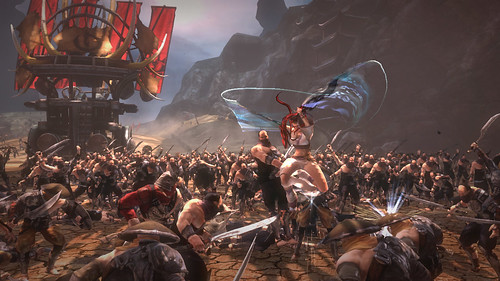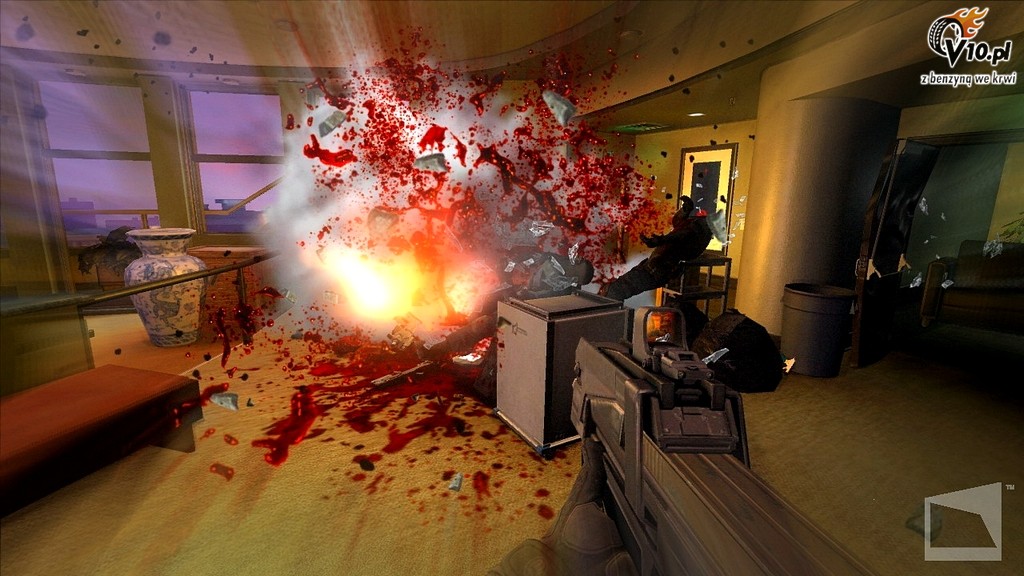 |
| This poster is misleading... |
Monsters is the latest film in the current new wave of independently made sci-fi/horror movies. Premiering at this year’s South by South West film festival in March, Monsters has gained much buzz through favorable reviews and word of mouth. Directed by British special effects creator Gareth Edwards on a budget of just under $200000, the script is mostly improvised, the CGI all created on the director’s laptop, the entire movie filmed on location in Mexico by a crew of seven people which includes the starring cast Whitney Able and Scoot McNairy. Indeed, the story of Monsters’ production almost eclipses the premise of the actual movie itself. The premise of which is very simple.
Monsters begins by establishing a backstory: six years ago, a NASA space probe carrying recently discovered alien life crash lands in Central America, conveniently infecting much of the land surrounding the US/Mexican border. Now cordoned off as the ‘infected zone’ US and Mexican military forces are engaged with an ongoing war against the giant octopus like space aliens that now inhabit the area. The central storyline begins in Mexico where troubled photo journalist Andrew Kaulder is reluctantly tasked with escorting his boss’s daughter Samantha Wynden back to US soil. Unfortunately, with things in movies never being as simple as boarding a flight from the nearest airport, the pair are forced to journey through the infected zone and witness several close encounters with the third kind in order to get home to lead their normal everyday lives.
Monsters both is and isn’t a conventional sci-fi monster movie. In essence, it does follow the routine traditions of the greatest of these movies, where a society of some kind is threatened by an other worldly force. Where it breaks from convention, or at least follows in the wake of Neill Blomkamp’s District 9, is where that moment of first contact is bypassed in favour of depicting a world and society that has gotten used to the presence of extra terrestrial life. Again, like District 9, the world of Monsters essentially documents how society struggles to cope with these oblivious creatures and the effort of authorities to contain them. In the pre title sequence, which is not unlike Cloverfield, we watch grainy black and white footage of US marines fighting one of the monsters before camera footage from a nose cone of a cruise missile comes in to finish the creature off. At the moment of the explosion, the camera cuts out and the movie’s title appear in practical silence. It is clear from the outset, then, that the monsters of the movie’s title may not be the actual aliens themselves but more the human's with their viking ways. I know its very deep.
Like District 9, the location of Monsters is the basis of much of the movie’s social commentary. The influx of illegal immigrants across the tortilla curtain has been a problem with which the US government has long been trying to regulate. The labeling of this particular stretch of land as the ‘infected zone’ is an apt metaphor for the summation of the tempestuous history of US border control, but the fact that the US army rather narrow mindedly perceive the monsters as threats to be exterminated is perhaps a rather clichéd depiction of US foreign policy which obviously stems from the ongoing war on terrorism. Edwards’ monsters are largely unthreatening, it is only when in the presence of weapons that they become defensive and dangerous. With civilians more than likely being caught up in the crossfire. You would have thought NASA, of all organizations, would have figured out the nature of these creatures, the fact that they are not the monsters that society hem claims to be. I mean, has no one thought to send in David Attenborough to gain a further understanding of these creatures’s existence? Media is not given a good rep in this movie obviously, perhaps rightly, with Kaulder's musings on how the picture of a dead child is going to pay him $50,000. Added to this, the whole film is coloured by a kind of humanitarian backpacker ideology, which comes to a foray when our travelers see the massive walls built on the US border, designed to keep the aliens out of American soil. This has been shown in contrast to the fairly budget Jurassic Park fencing that exists on the Mexican side of the Infected Zone. Looking 'in' on the US, the characters refer to the country as a prison cell containing a population of self-absorbed people largely ignorant to the woes and struggles of other less developed countries, which striked me as a little naïve, especially when you consider the country’s sheer size and its own problems born out of the fragmentation of social classes. I mean did New Orleans never happen in this alien infested universe? It is all up for discussion however, which is definitely to the film’s advantage.
This is also essentially back story as well, Monsters is better described, simply, as a love story; or at least the meeting of a man and woman within the chaos and complexity of a world, which just so happens to be inhabited by these monolithic many tentacled space aliens. It could also be described as a road movie, where the journey is more important than the destination. In many ways I couldn’t help feel a touch of Spielberg throughout. There were a couple of nods to Jurassic Park, several moments for instance where I begged out loud in the cinema for the actors to turn the lights off. The design of the aliens are not unlike an organic version of the tripod walkers in the War of the Worlds remake. Surpassing both these movies however, is Monster’s spiritual connection to Spielberg’s first short feature, Amblin. A story which involves boy meeting girl who find themselves bonding through the advent of travel, as they amble through the desert to the beach. Social commentary aside, the personal story, the journey of the two leads is what shines most in this movie. Connections to Spielberg is only a compliment to Gareth Edwards. He made all this with a low budget, what could he be capable of making with the full backing of studio endorsement? Film buffs are certain to follow this director’s career with great anticipation from here on in.
 |
| Social commentary in action: US/Mexican border = Baaad... |
Monsters is likely to divide audiences. It has been marketed as a monster movie, in the vein of Cloverfield, for the purposes of drawing in larger crowds. This is probably going to work against the movie as some viewers are likely to be disappointed in the slow burning character driven pace of the movie. They’ll have to wait for JJ Abram’s next movie, Super 8, scheduled for release next year in order to gain their next malevolent monster fix. Viewers of a more open mind however, will find much to like with Monsters. The film is beautifully shot, capturing the earnest joy of travel through colourful skies and the awe inspiring landscape of central America. The monsters themselves have a certain majesty and mystery. It is hard to belief that the director animated them upon a laptop, but he does so with subtlety to a degree that never spoils the creature’s mystique. The two leads play their roles excellently adding depth to their characters in a way that is familiar but by no means stereotypical, their on screen chemistry a result of their real life relationship. Overall, Monsters manages to be a tightly focused movie set within a grand and wonderfully realized world. A real nourishing mix of genres, a romance at its core, layered with sci-fi elements and socio-political sub text. An art house movie with space aliens, worthy of recommendation to any self respecting cinephile, who is eager for a slightly different experience at the cinema and is prepared to also make the journey themself.










